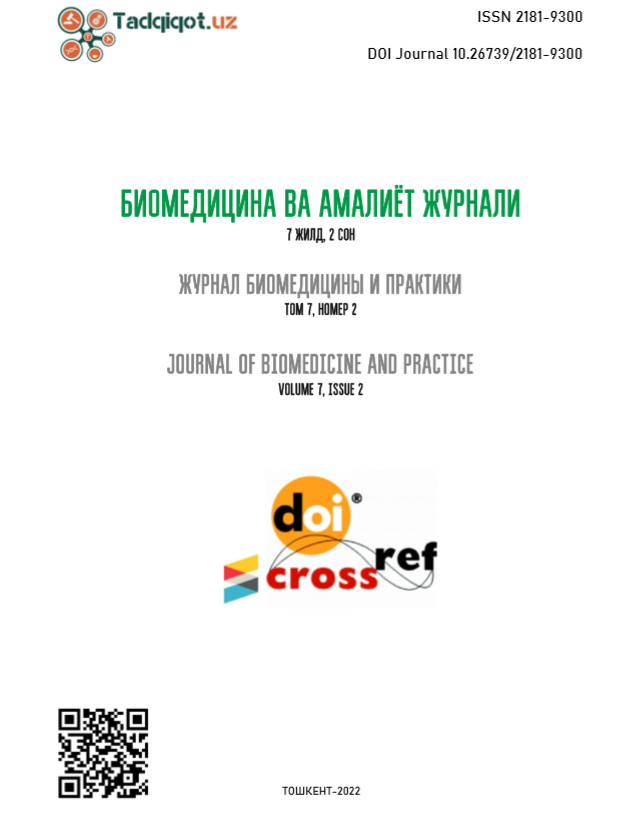CHARACTERISTIC FEATURES OF THE CLINICAL PICTURE OF CALCULOUS PYELONEPHRITIS IN CHILDHOOD DEPENDING ON AGE GROUPS
Keywords:
urolithiasis, children of different ages, calculous pyelonephritis, calculous pyelonephritis clinic, urinary stone diseaseAbstract
Purpose: to determine the characteristic features of the clinicopathology of calculous pyelonephritis among children of different age groups.
Methods: in a case-control study, 93 children aged 1 to 14 years with calculous pyelonephritis were included and clinical and laboratory-instrumental investigations were performed.
Results obtained: in the age groups of children with calculous pyelonephritis there were significant differences in the frequency of major symptoms: in children aged 1 to 3 years proteinuria (71%), dysuria (67%), leukocytosis (62%) were registered more frequently, while in the groups of children aged 4-7 years and 8-14 years leukocyturia, proteinuria and pain were registered more frequently. The frequency indicated is common in all patients between 1 and 14 years of age. However, there is considerable variation between age groups. So, for the younger age group (1-3 years) the follow-up was as follows: proteinuria, bacteriuria, dysuria, leucocyturia, pain, haematuria. In children of middle age group: leukocyturia, pain, proteinuria, hematuria, bacteriuria, dysuria. In the older age group the signs were distributed in the same sequence as in the whole group, except for changing the places of bacteriuria and dysuria.
Conclusions. Our findings indicate that the diagnosis of calculous pyelonephritis should be based on the age-related features of the course of the disease. The main diagnostic sign is the presence of a concrement in the urinary tract. Other main signs (presented in descending order of frequency) are, leucocyturia, pain proteinuria, haematuria, bacteriuria, dysuria.
References
Бакетин, П.С. Патогенетические варианты мочекаменной болезни // П.С. Бакетин, Р.А. Моллаев, Д.А. Мазуренко, В.Е. Григорьев, фрагментов // Н.К. Гаджиев, В.Е. Григорьев, В.В. Дмитриев, Н.С. Тагиров, В.Д. Король, В.М. Обидняк, А.В. Писарев, С.С. Бровкин, Х.Н. Байрамов, С.Б. Петров // Урологические ведомости. – 2017. – Т. 7. ( спецвыпуск). – С. 26.
Балуева Л.Г. Клинико-лабораторные особенности пиелонефрита, протекающего с кристаллурией у детей, и усовершенствование методов лечения // Автореф. дис. ... канд. мед. наук. Пермь; 2014. 23 с.
Белай, С.И. Мочекаменная болезнь: актуальность вопроса и перспективы его развития // Вестник ВГМУ. Украина. - 2016. - Т. 15, № 5. - С. 19-26.
Винниченко Л.В., Исмаилова И.А., Делягин В.М. Аспекты диагностики мочекаменной болезни. Участковый педиатр, 2017; 5: 24.
Винниченко Л.В., Исмаилова И.А., Делягин И.М. Педиатрические аспекты мочекаменной болезни. Практическая медицина. 2018. Том 16, № 8. С. 27-33.
Гаджиев, Н.К. Метафилактика мочекаменной болезни: новый взгляд, современный подход, мобильная реализация / Н.К. Гаджиев, С.С. Бровкин, В.Е. Григорьев, В.В. Дмитриев, В.А. Малхасян, Д.Д. Шкарупа, А.В. Писарев, Д.А. Мазуренко, В.М. Обидняк, И.Н. Орлов, С.В. Попов, Н.С. Тагиров, С.В. Петров // Урология. – 2017. – No 1. – С. 124-129.
Голощапов Е.Т. Четвериков А.М., Белозеров Е.С. Инфекционный фактор в генезе уролитиаза. Урологические ведомости 2016;6(4):21-6.
Гресь А.А., Ниткин Д.М., Юрага Т.М., Сиваков А.А. / Цистин как фактор риска камнеобразования в почках: референсные значения экскреции с мочой, этапная диагностика нарушения обмена // Урология. - 2016. - No 4. - С. 10-14.
Григорьев, Н.А. Мочекаменная болезнь / Н.А. Григорьев, И.В. Семенякин, В.А. Малхасян, Н.К. Гаджиев, В.И. Руденко // Урология. – 2016. – No S2. – С. 37-69.
Дзеранов Н.К. Современный подход к диагностике и лечению мочекаменной болезни у детей. Лечащий врач. 2016; 10: 62-5.
Руководство по клинической лабораторной диагностике заболеваний почек у детей. Под ред. Э.А. Юрьевой, B. В. Длина. М.: Оверлей, 2020. 244 c.
Шамсиев А.М., Юсупов Ш.А., Данияров Э.С. «К лечению обструктивного гнойного калькулёзного пиелонефрита у детей. Материалы научно-практической конференции. Ташкент, 2008, с. 84-85.
Donaldson JF, Ruhayel Y, Skolarikos A et al (2019) Treatment of bladder stones in adults and children: a systematic review and meta-analysis on behalf of the European association of urology urolithiasis guideline panel. Eur Urol 76(352):367.
Dongol UMS, Limbu Y. Safety and Efficacy of Percutaneous Nephrolithotomy in Children. J Nepal Health Res Counc . 2017; 15(2):130–134. doi: 10.3126/jnhrc.v15i2.18192.
Edvardsson V (2016) Urolithiasis in Children. In: Avner ED, Harman WE, Niaudet P, Yoshikawa N, Emma F, Goldstein SL (eds) Pediatr Nephrol. 7th edn: 1821–1868.
European Association of Urology. Clinical guidelines 2019. uploads/2019/09/89P-EAU_2019_Block_Disk.pdf.
European Association of Urology. Guidelines 2018 . Available online: https://uroweb.org/wp-content/uploads/EAU-Guidelines-2018-compilation-of-all-guidelines.pdf. Accessed on April 26, 2021.

